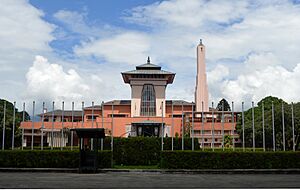Nepalese royal massacre facts for kids
Quick facts for kids Nepalese royal massacre |
|
|---|---|

The Narayanhiti Palace, former home of the royal family. Following the abdication of the king and the founding of a republic, the building and its grounds have been turned into a museum.
|
|
| Location | Tribhuvan Sadan, Narayanhiti Durbar, Kathmandu, Nepal |
| Coordinates | 27°42′56″N 85°19′12″E / 27.7156°N 85.32°E |
| Date | 1 June 2001 (19 Jestha 2058 Nepal B.S.) Around 21:00 (UTC+05:45) |
| Target | The Nepalese royal family |
| Weapons |
|
| Deaths | 10 (including the perpetrator) |
|
Non-fatal injuries
|
5 |
| Assailant | Crown Prince Dipendra of Nepal |
The Nepalese royal massacre was a tragic event that happened on June 1, 2001. It took place at the Narayanhiti Palace in Kathmandu, which was the home of the royal family of Nepal. During a family gathering, nine members of the royal family lost their lives. This included King Birendra and Queen Aishwarya.
An official investigation later stated that Crown Prince Dipendra was responsible for the deaths. After the event, Dipendra was in a coma due to a self-inflicted injury. Even while in a coma, he was declared the new King of Nepal. However, he passed away three days later without waking up. After his death, his uncle, Gyanendra, became king.
Contents
Why Did It Happen? Exploring Motives
The exact reasons behind the tragic events are still not fully known. There are different ideas and theories about what might have happened.
Disagreement Over Marriage Plans
One main theory suggests that Crown Prince Dipendra wanted to marry a woman named Devyani Rana. He had met her while studying in the United Kingdom. However, some people believe that the royal family did not approve of this marriage. They might have had concerns about her family's background or political connections.
Another idea related to marriage was that the royal family had chosen a different bride for Dipendra. This chosen bride was from an important Nepalese family, the Rana dynasty.
Concerns About Political Power
Another theory suggests that Dipendra might have been unhappy with changes happening in Nepal's government. Before this time, Nepal was an absolute monarchy. This meant the king had all the power. But after the 1990 People's Movement, Nepal became a constitutional monarchy. In this system, the king's power is limited by a constitution, and elected officials have more say. Some believe Dipendra might have felt that the royal family had given away too much power.
Unanswered Questions and Controversy
Even after the monarchy in Nepal ended in 2008, many questions about the massacre remain unsolved. People still wonder about several things:
- Why was there not much security during the royal family gathering?
- Why was Prince Gyanendra, Dipendra's uncle who later became king, not present at the event?
- Dipendra was right-handed, but his injury was on the left side of his head. This has led to questions.
- The official investigation into the event lasted only two weeks. Some people felt it was too short and did not include enough detailed scientific analysis, even though experts from Scotland Yard offered to help.
Who Was Affected? Victims of the Tragedy
The event resulted in the deaths of several members of the royal family and injuries to others.
Those Who Died
- King Birendra
- Queen Aishwarya
- Crown Prince Dipendra (who later became king for a short time)
- Prince Nirajan, King Birendra's younger son
- Princess Shruti, King Birendra's daughter
- Prince Dhirendra, King Birendra's younger brother
- Princess Shanti, King Birendra's eldest sister
- Princess Sharada, King Birendra's middle sister
- Kumar Khadga, Princess Sharada's husband
- Princess Jayanti, King Birendra's first cousin
Those Who Were Injured
- Princess Shova, King Birendra's youngest sister
- Kumar Gorakh, Princess Shruti's husband
- Princess Komal, Prince Gyanendra's wife
- Ketaki Chester, King Birendra's first cousin
See also
- List of massacres in Nepal
- List of regicides
- 2009 attack on the Dutch royal family
- Murder of the Romanov family

